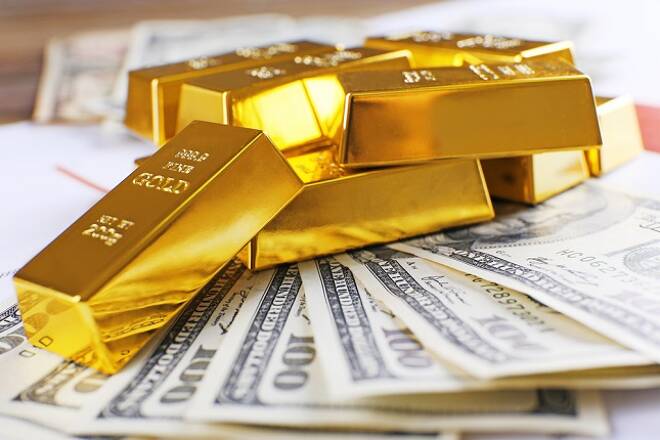Advertisement
Advertisement
Price of Gold Fundamental Weekly Forecast – At the Mercy of U.S. Dollar
By:
This week will tell us if Friday’s rally was real buying or just a knee-jerk reaction to the jobs report. The direction of the U.S. Dollar will exert most of the influence on gold prices. If the U.S. Dollar resumes its rally then gold prices are likely to be limited or may even retreat.
Gold prices were set to finish the week lower until Friday when a combination of weak economic news reports fueled a huge flight-to-safety rally, saving the market from its third consecutive weekly loss. Gold was also influenced by the weaker U.S. Dollar Index, which fell after the U.S. released a mixed Non-Farm Payrolls report. A dip in risk sentiment also pressured demand for stocks. This helped make gold a more attractive safe-haven investment.
Last week, April Comex Gold settled at $1299.30, up $0.10 or +0.01%. This was up from a weekly low of $1280.80.
Strong Dollar Drives Prices Lower
A stronger U.S. Dollar kept a lid on gold prices most of the week as investors responded to dovish announcements from major central banks including the Bank of Canada and the European Central Bank.
In the Euro Zone on Thursday, European Central Bank President Mario Draghi said the European economy was in “a period of continued weakness and pervasive uncertainty”. Conditions in the Euro Zone were perceived as so bad that the ECB: pushed back the timing of its first post-crisis interest rate hike to 2020, cut its economic forecasts and launched a new round of cheap bank loans.
“A new series of quarterly targeted longer-term refinancing operations (TLTRO-III) will be launched, starting in September 2019 and ending in March 2021, each with a maturity of two years,” the central bank said in a statement.
The TLTROs are loans that the ECB provides at cheap rates to banks in the Euro area. The central bank’s decision comes at a time when there are increasing concerns about growth in the Euro Zone. ECB President Mario Draghi also cited a series of external risks as a reason for the new measures.
“The persistence of uncertainties related to geopolitical factors, the threat of protectionism and vulnerabilities in emerging markets appears to be leaving marks on economic sentiment,” Draghi told reporters Thursday.
The ECB also kept interest rates unchanged Thursday but updated its guidance for a rate hike. The ECB had previously said that rates would remain at these levels through to the end of summer, but Thursday, it said it now expects its key interest rates “to remain at their present levels at least through the end of 2019.”
The U.S. Dollar also strengthened against the Canadian Dollar after the Bank of Canada (BOC) left its overnight rate at 1.75 percent as expected, citing a slowdown in the global, as well as Canadian economies.
“Recent data suggest that the slowdown in the global economy has been more pronounced and widespread than the Bank had forecast in its January Monetary Policy Report,” said the Bank in a statement announcing the rate hold. “While the sources of moderation appear to be multiple, trade tensions and uncertainty are weighing heavily on confidence and economic activity. It is difficult to disentangle these confidence effects from other adverse factors, but it is clear that global economic prospects would be buoyed by the resolution of trade conflicts.”
The USD/CAD rose as investors reduced the odds of further BOC rate hikes later this year. In 2018, the central bank suggested it would be aggressive in raising the rate throughout 2019, but it now looks as if the Bank will not make another rate move until the fall, with some experts suggesting the Bank could lower the rate.
Risk Sentiment Tumbles
Gold was also boosted as demand for global equities was pressured by a drop in risk sentiment. The catalyst behind the stock market weakness was weaker-than-expected trade balance data from China and a surprise drop in the number of U.S. jobs added in February.
In China on Friday, dollar-denominated February exports fell 21 percent from a year earlier. This was the biggest drop in three years and far worse than analysts had expected. Imports also dropped 5.2 percent.
U.S. government data showed the economy added just 20,000 jobs in February, compared with estimates for a gain of 180,000 positions. Somewhat offsetting the news was a drop in the unemployment rate to 3.8 percent. Average hourly earnings were another positive, increasing by 3.4 percent on year over year.
Weekly Forecast
This week will tell us if Friday’s rally was real buying or just a knee-jerk reaction to the jobs report. The direction of the U.S. Dollar will exert most of the influence on gold prices. If the U.S. Dollar resumes its rally then gold prices are likely to be limited or may even retreat.
Treasury yields and investor demand for the safe-haven dollar could also help limit demand for gold. Traders will also be focused on risk sentiment with the stock market being the most influential catalyst.
Gold traders will also be watching for fresh news about a trade deal between the U.S. and China. An announcement of a deal is likely to be bearish for gold prices since speculators will increase bets that it leads to future economic growth.
About the Author
James Hyerczykauthor
James Hyerczyk is a U.S. based seasoned technical analyst and educator with over 40 years of experience in market analysis and trading, specializing in chart patterns and price movement. He is the author of two books on technical analysis and has a background in both futures and stock markets.
Advertisement
